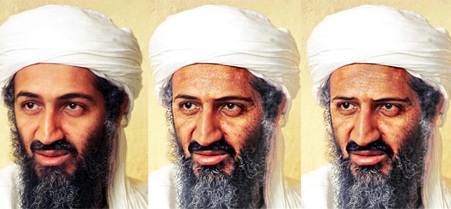FBI aging technique led to bin Laden mug mixup, IT professor says
New technology that uses physics, science of plastic surgery and computer graphics portrays how a person naturally ages, providing a more accurate portrayal.
 A software program's rendering of how Osama bin Laden would age in 15 years (center) and 30 years (right).
A software program's rendering of how Osama bin Laden would age in 15 years (center) and 30 years (right).
The FBI should have focused on the physical aging of the suspect's unique skin type during a recent computerized age progression of Osama bin Laden instead of simply combining facial features from other photographs, says an expert on face detection and image processing algorithms.
Last week, the FBI took offline an age-enhanced depiction of the terrorist, after acknowledging similar hairline features in the bureau's rendering and an online photograph of Spanish politician Gaspar Llamazares.
"If I was looking for hairlines, I would perhaps look for a photo of bin Laden," said Parham Aarabi, chief executive officer of face visualization firm Modiface and an associate professor in the electrical and computer engineering department at the University of Toronto. "I would have used as much of Osama's own photo as possible."
FBI forensic artists typically produce age progressions by picking features from a database of stock reference photographs to create a new image, bureau officials said. In this instance, it seems the artist could not find suitable features among the photographs, they said. The bureau artist obtained features for the likeness partly from a photograph that he found on the Internet; he was unaware of Llamazares' identity and the similarities were unintentional and inadvertent, officials added.
Modiface generated an age-enhanced photo of bin Laden in five seconds using an automated, Web-based tool without any manual user intervention or editing, and without additional photos or illustrations, Aarabi said. Modiface last week made the tool available free to the public, hoping that the law enforcement community will experiment with it.
The application harnesses physics, the science behind plastic surgery, and computer graphics to illustrate how a person in a single photograph might age.
"About five to 10 years ago, the software that existed involved adding overlays -- or taking elements of a photo [of an older person] and adding it to a photo that they wanted to age," Aarabi said. "The new way is to try to understand a person's face and see how that person would naturally age -- use physics and computer graphics in that sense to see realistically how my hairline and my skin will change as I get older."
Aarabi explained the technology ages particular facial features, such as the sagging of the skin and the brows, loss of volume in the lips and the whitening of the hair. The key to lifelike virtual aging is incorporating a person's own facial characteristics and then morphing those features, instead of superimposing features from external photographs, he said.
FBI officials declined to comment on Aarabi's assessment of its computer imaging.
Modiface had planned to launch the application in February, but the FBI incident prompted the company to release the software early.
Aarabi cautioned that the technology is not perfect and law enforcement should consider it a starting point.
NEXT STORY: The Army's Five Year Afghanistan Plan



